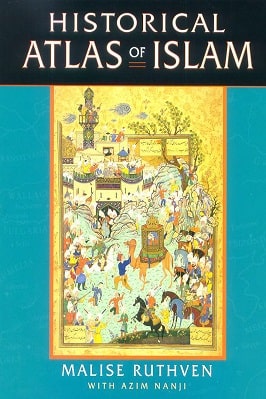
| Book Title | Historical Atlas Of The Islamic World |
| Book Author | Malise Ruthven |
| Total Pages | 210 |
| Book Views | |
| Language | English |
| Book Download | PDF Direct Download Link |
| Get Hardcover | Click for Copy from Amazon |
Historical Atlas of The Islamic World by Malise Ruthven with Azim Nanji
- Foundational Beliefs and Practices 14
- Geophysical Map of the Muslim World 16
- Muslim Languages and Ethnic Groups 20
- Late Antiquity Before Islam 24
- Muhammad’s Mission and Campaigns 26
- Expansion of Islam to 750 28
- Expansion 751–1700 30
- Sunnis, Shiites, and Khariji 660–c. 1000 34
- Abbasid Caliphate under Harun al-Rashid 36
- Spread of Islam, Islamic Law, and Arabic Language 38
- Successor States to 1100 40
- The Saljuq Era 44
- Military Recruitment 900–1800 46
- Fatimid Empire 909–1171 50
- Trade Routes c. 700–1500 52
- Crusader Kingdoms 56
- Sufi Orders 1100–1900 58
- Ayyubids and Mamluks 62
- The Mongol Invasion 64
- Maghreb and Spain 650–1485 66
- Subsaharan Africa—East 70
- Subsaharan Africa—West 72
- Jihad States 74
- The Indian Ocean to 1499 76
- The Indian Ocean 1500–1900 80
- Rise of the Ottomans to 1650 84
- The Ottoman Empire 1650–1920 88
- Iran 1500–2000 92
- Central Asia to 1700 94
- India 711–1971 96
- Russian Expansion in Transcaucasia and Central Asia 102
- Expansion of Islam in Southeast Asia c. 1500–1800 106
- British, French, Dutch, and Russian Empires 108
- Nineteenth-Century Reform Movements 110
- Modernization of Turkey 112
- The Muslim World under Colonial Domination c. 1920 116
- Balkans, Cyprus, and Crete 1500–2000 118
- Muslim Minorities in China 122
- The Levant 1500–2002 124
- Prominent Travelers 128
- Britain in Egypt and Sudan in the 19th Century 132
- France in North and West Africa 136
- Growth of the Hajj and Other Places of Pilgrimage 138
- Expanding Cities 142
- Impact of Oil in the 20th Century 146
- Water Resources 148
- The Arms Trade 150
- Flashpoint Southeast Asia 1950–2000 152
- Flashpoint Iraq 1917–2003 154
- Afghanistan 1840–2002 156
- Arabia and the Gulf 1839–1950 158
- Rise of the Saudi State 160
- Flashpoint Israel–Palestine 162
- Flashpoint Gulf 1950–2003 164
- Muslims in Western Europe 166
- Muslims in North America 168
- Mosques and Places of Worship in North America 170
- Islamic Arts 172
- Major Islamic Architectural Sites 176
- World Distribution of Muslims 2000 180
- World Terrorism 2003 184
- Muslim Cinema 188
- Internet Use 190
- Democracy, Censorship, Human Rights, and Civil Society 192
- Modern Islamic Movements 194
- Chronology 196
- Glossary 200
- Further Reading 203
- Acknowledgments and Map List 204
- Index 205
HISTORICAL ATLAS OF THE ISLAMIC WORLD
Since September 11th, 2001, barely a day passes without stories about Islam—the religion of about one-fifth of humanity—appearing in the media.
The terrorists who hijacked four American airliners and flew them into the World Trade Center in New York and the Pentagon near Washington killed some three thousand people.
This unleashed a “War on Terrorism” by the United States and its allies, leading to the removal of two Muslim governments, one in Afghanistan and the other in Iraq. It raised the profile of Islam throughout the world as a subject for analysis and discussion.
The debates, in newspaper columns and broadcasting studios, in cafes, bars, and homes, have been heated and passionate. Questions that were previously discussed in the rarified atmosphere of academic conferences or graduate seminars have entered the mainstream of public consciousness.
What is the “law of jihad”? How is it that a “religion of peace” subscribed to by millions of ordinary, decent believers, can become an ideology of hatred for an angry minority? Why has Islam after the fall of communism become so freighted with passionate intensity?
Or, to use the title of a best-selling essay by Bernard Lewis, the doyen of Orientalist scholars, “What went wrong?” with Islamic history, with its relationship with itself, and with the modern world? Such questions are no longer academic but are arguable of vital concern to most of the people living on this planet.
Few would deny that Islam, or some variation thereof— whether distorted, perverted, corrupted, or hijacked by extremists—has become a force to be reckoned with or at least a label attached to a phenomenon with menacing potentialities.
Numerous atrocities have been attributed to and claimed by Islamic extremists, both before and since 9/11, causing mayhem and carnage in many of the world’s cities and tourist destinations: Nairobi, Dar es Salaam, Mombasa, Riyadh, Casablanca, Bali, Tunisia, Jakarta, Bombay (Mumbhai), Istanbul and Madrid.
The list grows longer, the casualties mount. The responses of people and their governments are angry and perplexed.
The far-reaching consequences of these responses for international peace and security should be enough to convince anyone (and not just the media editors who mold public consciousness to fit their advertisers’ priorities) that extreme manifestations of Islam are setting the agenda for argument and action in the twenty-first century.
Muslims living in the West and in the growing areas of the Muslim world that come within the West’s electronic footprint understandably resent the negative exposure that comes with the increasing concerns of outsiders. Islam is a religion of peace: the word “Islam,” a verbal noun meaning submission
To read more about the Historical Atlas Of The Islamic World book Click the download button below to get it for free
or
Report broken link
Support this Website
 Don't Miss out any Book Click Join OpenMaktaba Telegram group
Don't Miss out any Book Click Join OpenMaktaba Telegram group